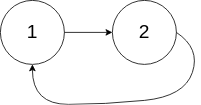
📢 preface
| 🚀 Algorithm problem 🚀 |
- 🌲 Punching out an algorithm problem every day is not only a learning process, but also a sharing process 😜
- 🌲 Tip: the problem-solving programming languages in this column are C# and Java
- 🌲 To maintain a state of learning every day, let's work together to become the great God of algorithm 🧐!
- 🌲 Today is the 38th day of punching out the force deduction algorithm 🎈!
| 🚀 Algorithm problem 🚀 |
🌲 Example of original question: circular linked list
Given a linked list, judge whether there are links in the linked list.
If there is a node in the linked list that can be reached again by continuously tracking the next pointer, there is a ring in the linked list. In order to represent the rings in a given list, we use the integer pos to represent the position where the tail of the list is connected to the list (the index starts from 0). If pos is - 1, there is no ring in the linked list.
Note: pos is not passed as a parameter, but only to identify the actual situation of the linked list.
Returns true if there are links in the linked list. Otherwise, false is returned.
Example 1:

Input: head = [3,2,0,-4], pos = 1 Output: true Explanation: there is a ring in the linked list, and its tail is connected to the second node.
Example 2:

Input: head = [1,2], pos = 0 Output: true Explanation: there is a ring in the linked list, and its tail is connected to the first node.
Example 3:

Input: head = [1], pos = -1 Output: false Explanation: there are no links in the linked list.
Tips:
- The number range of nodes in the linked list is [0, 104]
- -105 <= Node.val <= 105
- pos is - 1 or a valid index in the linked list
🌻 C# method: double pointer
Train of thought analysis
The fast and slow pointer starts from the node at the same time. The fast pointer takes two steps at a time and the slow pointer takes one step at a time. If there is a ring, the fast pointer will catch up with the slow pointer sooner or later.
code:
public class Solution {
public bool HasCycle(ListNode head)
{
ListNode slow = head;
ListNode fast = head;
while (fast != null && fast.next != null)
{
slow = slow.next;
fast = fast.next.next;
if(slow == fast)
{
return true;
}
}
return false;
}
}
results of enforcement
adopt Execution time: 92 ms,At all C# Defeated 74.50% of users in submission Memory consumption: 26.6 MB,At all C# Beat 75.17% of users in submission
🌻 Java method: hash table
Train of thought analysis
The easiest way to think of is to traverse all nodes. Each time you traverse a node, judge whether the node has been accessed before.
Specifically, we can use a hash table to store all the nodes that have been accessed.
Every time we reach a node, if the node already exists in the hash table, it means that the linked list is a ring linked list, otherwise the node will be added to the hash table. Repeat this process until we traverse the entire linked list.
code:
class Solution {
public boolean isPalindrome(String s) {
StringBuffer sgood = new StringBuffer();
int length = s.length();
for (int i = 0; i < length; i++) {
char ch = s.charAt(i);
if (Character.isLetterOrDigit(ch)) {
sgood.append(Character.toLowerCase(ch));
}
}
StringBuffer sgood_rev = new StringBuffer(sgood).reverse();
return sgood.toString().equals(sgood_rev.toString());
}
}
results of enforcement
adopt Execution time: 4 ms,At all Java Defeated 20 in submission.23%User Memory consumption: 39.1 MB,At all Java Defeated 83 in submission.75%User
Complexity analysis
Time complexity: O( N ),among N Is the number of nodes in the linked list Space complexity: O( N ),among N Is the number of nodes in the linked list
💬 summary
- Today is the 38th day of punch in of force deduction algorithm!
- This paper uses C# and Java programming languages to solve problems
- Some methods are also written by Likou God, and they are also shared while learning. Thanks again to the algorithm bosses
- That's the end of today's algorithm sharing. See you tomorrow!

🚀 Previous high-quality article sharing
- ❤️Unity zero foundation to entry | systematic learning route of game engine unity from 0 to 1 [comprehensive summary - suggestions collection]!
- 🧡Spend a day doing a high-quality aircraft war game and have a complete tutorial of 10000 words Unity! Beautiful Xuemei looked and called 666!
- 💛Back to childhood classic series ☀️| [bomb man game] production process + analysis | collect it and dream back to childhood with your former friends!
- 💚A first person shooting game Demo similar to CS made all night! It's not difficult to play games
- 🤍Explosive liver wrote a real-time combat game Demo similar to the Royal war all weekend! More than 20000 word game production process + analysis!
- 💙How to make a horizontal arcade fighting game similar to "dinosaur quick fight"| Learn together and send the source code by the way [code text is not easy, it is recommended to collect and learn]
- 💜Back to childhood classic series ☀️| [Snake game] nearly 20000 words complete production process + analysis + source code [recommended collection and learning]